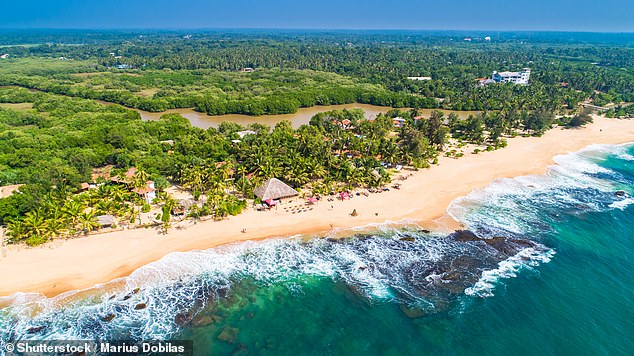Thursday morning in the Tangalle harbor and barefoot fishermen wearing colorful saris and toothless grins carry thousands of silver and blue fish on the back of their boats.
Behind them, huge multicolored wooden boats decorated with flags croak and groan as they push against the harbor walls and entire families crammed into green and red tuk-tuks navigate their way through the chaos, honking as they go.
It’s an intoxicating scene as the smell of fish guts and blood crackles through the pavement and the temperature reaches 35 degrees.
I’m here with my husband, Dan. We came to Sri Lanka ten years ago, backpacking, taking local trains between the east and west coasts and sleeping in wooden beach huts costing £10 a night. This time we explore the country’s south coast in a much more sophisticated way.
Sri Lanka, roughly the size of Wales, has had it tough in recent years. Just as it was getting back on its feet after the brutal civil war and tsunami in 2004, the Colombo bombing in 2019 put travelers off and then Covid hit. But, despite the tumbling economy, it is safe and the friendly locals welcome tourists with open arms.
The beach town of Tangalle is our first stop, home to colorful temples, world-class surf spots, bustling food markets and a population of 62,000.
While a string of simple guesthouses line the town’s seafront, most of the luxury hotels are just outside. One recent opening is Kayaam House, a 10-minute drive east.
Opened by Resplendent Ceylon, a luxury hotel group whose flagship hotel, Ceylon Tea Trails, featured on BBC2’s Amazing Hotels, Kayaam House is relaxed and affordable, with rooms from £200/$251.

On a tour of Sri Lanka’s south coast, Harriet Sime visits the beach town of Tangalle (photo)

Above, a golden Buddha statue in one of Tangalle’s array of colorful temples

Harriet stays at Kayaam House hotel (seen here), which is ‘relaxed and affordable, with rooms from £200’
Unfortunately the waves along the lovely beach are too fierce for us to swim or surf, so we are driven 20 minutes west to a surf spot where young locals with dreads and top knots sit on low walls, battered boards at their sides, as jerks of jazz from wooden beach bars floats through the air.
We meet our instructor, Viran, a leathery-skinned resident with pearly white teeth and limited English. He hands us blue rash jackets and a pair of 8ft foam boards before pointing to the water. We follow him – no safety briefing, no questions about our swimming abilities, no forms to sign away our lives.
Luckily we’ve had our fair share of lessons so we spend the last light of the day jumping on and off our boards as Viran watches. After an hour it is time to row back to shore where we are handed bottles of water and watch smartly dressed school children with waist-length braids walk along the beach.
Our second stop in Tangalle is Amanwella, west of town, high above Secret Beach, known for being one of the best bays in the south. And quite rightly so. Gigantic rolling turquoise waves crash onto the creamy yellow sand, which is backed by a dense jungle of lush deep green palms.
Like much of the Aman brand, rooms (or rather freestanding suites) here aren’t cheap (from £763 a night) – but they’re certainly impressive, peeking out from under a profusion of coconut palms that run down to the bay.
We are warned not to go into the sea, but cannot resist – so we leave the private part of the beach and go to the south side. A few brave tourists are whirled around by surging, swirling waves, their legs swinging before they come up for air. We jump in and let the sea push us along the shore, taking deep breaths and diving into the waves as they pound the silky sand.
Our next stop is Yala National Park, two hours east. Driving off the highway in Sri Lanka is an absolute joy. We pass through small towns where locals sell bananas in wooden huts, herds of bony water buffalo cause traffic jams, and colorful incense-scented temples give way to lagoons where fishermen in narrow wooden boats cast their nets.
We arrive at Wild Coast Tented Lodge, a remote safari camp made up of luxurious, cocoon-like tents inspired by the egg-shaped rocks strewn across the beach. We are taken to our tent, reminiscent of a time of great expeditions, with teak floors, leather chairs, a freestanding copper bath and private plunge pool overlooking a waterhole.

Above, Wild Coast Tented Lodge, which is Harriet’s base for exploring Yala National Park

Wild Coast consists of ‘luxurious, cocoon-like tents inspired by the egg-shaped rocks’, reveals Harriet

Harriet sees Sri Lankan leopards (pictured) and sloth bears in Yala National Park
We are introduced to our guide, Saranga, who wears a long beard with silver strands, before driving five minutes to Yala. Saranga shares compelling stories every time we come across a new animal (the elephant that killed the farmer who shot him in the leg two years earlier, the crocodile that spent months learning how to jump so he could catch a fisherman eat that would sit on a hanger. wooden platform every day).
The elephants are plentiful, and even a leopard we see comes easily to us, but it is the reclusive Sri Lankan sloth that eludes us. “We might only see them one in 15 drives,” Saranga warns us as we head back to the lodge on our final drive, red sand flashing in our wake.
And then I saw him. Lazily through the gnarled trees. “Stop, stop, stoppp,” I called and the jeep came to a stop. The bear looks at us nonchalantly as we sit in silence before lowering his hairless white snout and munching on a termite mound, occasionally licking his paws.
“He may look cute, but he’ll tear your face off if he gets the chance,” Saranga whispered. ‘My friend came across a bear while looking for a honey nest in the jungle. He knew to cover his face when he was attacked but ended up in hospital for three months.’
Our final stop is Galle Fort, the charming 17th-century walled town and Unesco World Heritage Site on Sri Lanka’s southwest coast.
Our base is Amangalla, a hotel in a 350-year-old cream-colored colonial building within the fort walls, where unfailingly warm staff in flowing white robes talk passionately about the hotel’s history while dishing up sublime food and drink.
That night, as we observe the sloth bear and discuss the rain pounding the cobbled streets outside, we hear an all-out slap, crack, pop and thud.
I cover my ears and crouch under the table as the local musicians stop playing in the corner and several staff rush outside. We are told that lightning struck the church next door, maybe only 10 meters away from where we are sitting.
We saw ferocious sloth bears and dodged lightning in one day – a thrilling reminder of the amazing power of nature.





